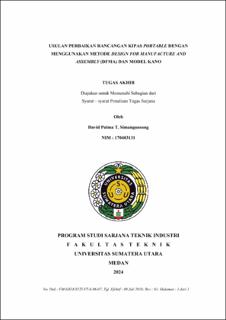Usulan Perbaikan Rancangan Kipas Portable dengan Menggunakan Metode Design For Manufacture and Assembly (DFMA) dan Model Kano
Proposed Design Improvement of Portable Fan Using Design of Manufacture and Assembly Method and Kano Method

Date
2024Author
Simangunsong, David Pulma T
Advisor(s)
Tambunan, Mangara Mangapul
Metadata
Show full item recordAbstract
Electronic devices are operated devices that use electrical energy as an energy
source and transform this energy into other energy. The use of electronic devices,
which have now become the main tool for society, will be hampered if the
electronic devices are damaged. One electronic device that often experiences
damage is a portable fan. Problems that occur in portable fan products through
observations at PT Industrial Multi Fan include damage and problems in the
portable fan assembly process. Problems with product damage include burnt out
dynamos, damaged components, and slow rotating fans. Problems in the assembly
process include a large number of components, design and use of components that
make the assembly process difficult and less efficient. The aim of this research is
to improve the design of portable fans to suit consumer needs and increase
product assembly efficiency. Improving the portable fan design begins with
identifying customer needs using the Kano Model, there are 3 attributes in the
attractive category, 1 attribute in the must bee category, and 6 attributes in the
indifferent category. The focus of repairing portable fans is based on 3 attractive
attributes, namely the use of nuts, depth of component insertion, and number of
components. Improvements to the kipas portable design were carried out using the
Design for Manufacture and Assembly (DFMA) method which takes into account
the ease of the manufacturing and assembly process. Improvements in the design
of the portable fan resulted in improvements to the design of the body cover and
bottom cover which replaced the function of nut A with a snap fit locking system
and reduced the installation depth of nut B to 0.5 cm. The results of these
improvements resulted in a reduction in assembly time from 264.33 seconds to
231.18 seconds, increased design efficiency from 24.97% to 25.95%, and reduced
assembly costs from IDR 712.30/unit to IDR 623.05/unit
Collections
- Undergraduate Theses [1597]
